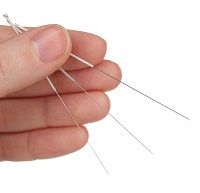Article
Believing Acupuncture Will Be Effective Reduced Pain in Breast Cancer Patients
Author(s):
Breast cancer patients who believed acupuncture would reduce their joint pain demonstrated significant pain reduction, no matter if they received real or placebo acupuncture.

Electro-acupuncture (EA) reduced joint pain by up to 40 percent in women with breast cancer, no matter if the patient expected it to work or not, according to research published in JNCI Monographs.
Researchers from the University of Pennsylvania Perelman School of Medicine aimed to evaluate the relationship between response expectancy — important to the longevity of the placebo effect over time – and treatment outcome in electro-acupuncture (“real” acupuncture) and sham electro-acupuncture (SA). By providing either real EA to SA to 41 breast cancer patients, plus a control group that received neither intervention, the researchers assessed joint stiffness and joint pain. The joint stiffness and pain are often attributed to be side effects of aromatase inhibitor, which is a hormone therapy used to aid the treatment of breast cancer. The patients were also given an Acupuncture Expectancy Scale (AES) to evaluate the strength of their belief in the intervention.
“Our study is the first to provide evidence that expectancy has no effect on whether real acupuncture works or not, but that high expectancy does appear to have a positive effect on patients who receive sham acupuncture,” the study’s senior author Jun J. Mao, MD said in a press release. “This issue extends beyond acupuncture and is important to all trials involving pain management that use placebos, such as drugs, procedures, and natural products.”
Patients who received either EA or SA experienced joint pain improvement over the 8 week trial period, but the association with expectancy differed between the groups. Control patients’ AES remained unchanged over the duration of the treatment period. SA patients experienced pain reduction as high as 80 percent if they also had a high scoring AES — which was about twice the rate of patients receiving EA – which the researchers acknowledged raises the question of whether patients could benefit from the non penetrative use of needles without electro-stimulation.
SA patients with low baseline expectancy scores did not report any significant pain reduction. Patients who reported pain relief had increased expectancy that the relief would continue to work over their treatment period compared to non responders. This suggested to the researchers that positive responses during the process of EA increased the expectations of further positive outcomes.
“These findings certainly challenge the notion held by some that acupuncture is ‘all placebo,’” the study’s lead author, Joshua Bauml, MD, continued in the statement. “If it were ‘all placebo,’ patients receiving real acupuncture who had low expectations that it would work would report little or no reductions in pain. But that’s not the case.”





